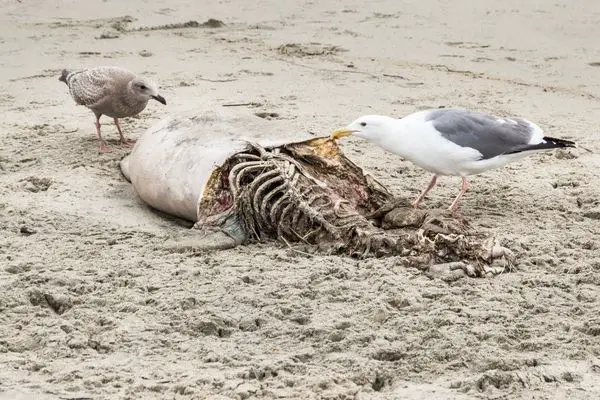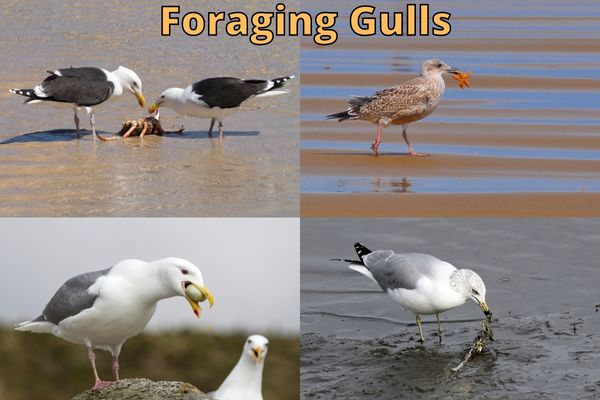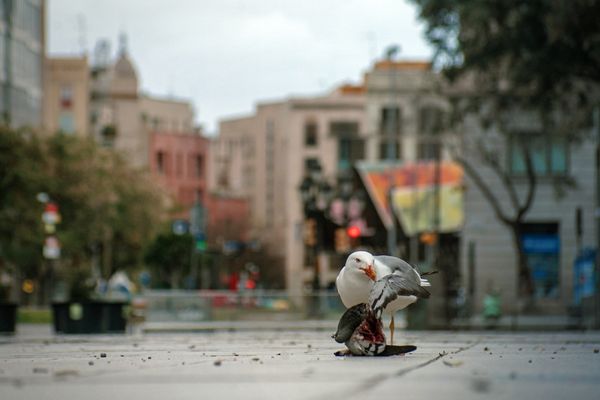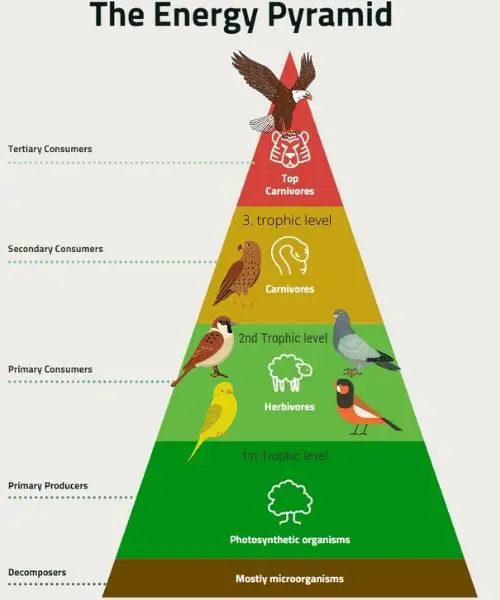Gulls (seagulls) are omnivorous birds that live near the coast. In the wild, gulls play an important role in the food web as they eat a wide variety of food items and sometimes also scavenge for food.
However, gulls are not true scavengers, but they can function as scavengers because they eat almost anything they come by! They mostly eat living things like fish, crustaceans, and insects, but they also eat carrion and garbage. So strictly speaking, they are just part-time scavengers but full-time omnivores!
Gulls are opportunistic feeders that will eat anything they can get. In the wild they mainly eat fish, crustaceans, insects, carrion, and garbage. Their diet changes between seasons, as different food types become more abundant or as they grow bigger and can handle larger food items.
Gulls are found on all continents, except Antarctica, and nearly every ocean. Gulls typically live in habitats close to water, both fresh- and saltwater but this is not always the case!

Gulls, are often incorrectly referred to as “seagulls” (but no gull species are restricted to living near the sea). Gulls are simply defined as a large family of birds characterized by white to gray feathers, stout bodies, and webbed feet.
They are typically coastal species, but some gulls live far inland in open grasslands, prairies, and even deserts and will never come close to the sea.
The lifestyles of these gulls can be very different from the gulls we typically meet in cities.
The gulls we know the best are the ones that have adapted to an urban lifestyle near, or in, big cities. These gulls are much more inclined to scavenge for food leftovers from humans than
Gulls typically breed in large colonies, often with other bird species. Gulls lay one to five eggs at a time. The chicks hatch fully feathered and with well-developed wings.
Can Seagulls be Considered Decomposers or Scavengers?
Gulls typically consume small fish and crustaceans, but a few species also scavenge.
Seagulls do not eat a diet made up exclusively of dead or decaying matter and are therefore not considered real decomposers or scavengers like vultures would be.

The bacteria in the gut of the seagull play a very important role in their digestion and these microorganisms are what we consider the true decomposers.
However, gulls do eat dead animals in the form of fish and other small animals, but also human leftovers. This helps reuse the nutrients of these small animals that would otherwise have to go through the slow process of decomposition by microorganisms on their own.
Why are Seagulls Important for the Ecosystem?
Seagulls play an important role in the ecosystem as scavengers and omnivores. They help to clean up the environment by eating dead animals and fish, as well as garbage. This helps to prevent the spread of disease and keeps the ecosystem healthy.
By eating dead animals, a seagull speeds up this process and offers some of the raw nutrients back to the environment when leaving its feces.

Seagulls are also important because they help to aerate the soil with their beaks and claws when they search for insects and worms. This helps to improve plant growth by providing oxygen to the roots. Additionally, their droppings are a natural source of fertilizer that can help plants grow better.
Finally, seagulls are important because they are a food source for other animals such as foxes, coyotes, and eagles. By eating seagulls, these animals help to keep the population in check and prevent them from becoming a nuisance.
Are Seagulls Carnivores, Herbivores or Omnivores?
Seagulls are omnivores because they eat both plants and animals. They will eat a variety of foods including grasses, seeds and grains but they do prefer to eat other animals as they are more nutritious.

Smaller seagulls, such as herring gulls, eat small fish and other fish. Larger seagulls, such as black-headed gulls, eat larger animals like fish, birds and mammals.
While being omnivores, they are also skilled hunters!
Gulls have a number of adaptations for the predator lifestyle in the wild.
Firstly, they have excellent eyesight. They can see both in the day and at night. Their eyesight is adapted to spot prey, especially in murky water.
Second, gulls also have very good flying abilities and they catch their dinner on the wing. This is possibly helped by their large wings, which help them soar and glide on thermals.
Third, gulls also use teamwork and watch for prey and predators! Gulls are actually fairly clever birds (although not as clever as crows and magpies!), and can almost be considered skilled killers.

These skills are, however, less useful in the cities. And who knows, maybe their sharp hunting instincts will diminish as they adapt further to an existence among humans!
Are Seagulls Producers, Consumers, or Decomposers?
Because seagulls need to acquire their energy from other living organisms, they are consumers and not producers or decomposers.
Seagulls are fascinating creatures that inhabit coastal areas around the world. When it comes to their ecological role, seagulls are primarily classified as consumers in the food chain. However, it’s important to note that their feeding habits can vary depending on the availability of resources and their specific environment.
As consumers, seagulls occupy a crucial position in the food web, acting as opportunistic scavengers and predators. They have a diverse diet that includes both plant and animal matter. Seagulls are known to consume a variety of marine life, such as fish, crustaceans, mollusks, and even small mammals.
Additionally, they opportunistically feed on insects, earthworms, rodents, and carrion. This adaptability allows them to thrive in different habitats, including coastal areas, estuaries, and urban environments.
While seagulls predominantly function as consumers, it’s worth noting that they indirectly contribute to the decomposition process. When seagulls scavenge on carrion or consume organic matter, they play a role in breaking down these materials and returning nutrients to the ecosystem.
Through their consumption and subsequent excretion, they contribute to nutrient cycling, aiding in the decomposition of organic matter and facilitating the growth of plants and other organisms.
Furthermore, seagulls can also exhibit some behaviors that may be considered as secondary producers. For instance, they can be seen hunting and catching small fish or foraging for invertebrates in intertidal areas. By acquiring and consuming these primary producers, such as phytoplankton or smaller marine organisms, seagulls indirectly obtain energy from the sun, essentially acting as consumers of the energy stored in these organisms.
Despite their status as consumers, seagulls have a complex and varied role within the ecosystem. Their feeding habits and interactions with other organisms are influenced by factors such as habitat availability, competition, and seasonal variations. It is this adaptability and versatility that enables seagulls to thrive and survive in diverse environments.
So, in conclusion, while seagulls are primarily classified as consumers due to their feeding habits, they also contribute to the decomposition process and can indirectly function as secondary producers. Their position in the food chain highlights the interconnectedness and complexity of ecosystems, where organisms fulfill multiple roles and play vital roles in maintaining the balance of nature.
What Type of Consumer is a Seagull?
Seagulls are omnivores and therefore secondary consumers.
Seagulls are considered secondary consumers because they eat other animals that mostly eat plants.
Secondary consumers eat other animals, while primary consumers eat plants. Secondary consumers are generally omnivores and eat both plants and animals.
Where are Seagulls in the Food Chain?
Seagulls are fairly low in the food chain because they mostly eat herbivore animals.
Animals that only eat plants are primary consumers and are placed on the second trophic level in the energy pyramid, but gulls are placed on the third trophic level.

Food chains simply demonstrate how energy moves from one organism to the next, in a straight line.
Seagulls occupy various positions within the food chain, depending on their specific environment and available food sources. In general, they can be classified as secondary consumers or tertiary consumers.
As secondary consumers, seagulls primarily feed on smaller marine organisms such as fish, crustaceans, mollusks, and invertebrates. These organisms, known as primary consumers or herbivores, obtain their energy by consuming primary producers like phytoplankton or aquatic plants. Seagulls play a crucial role in regulating the populations of these smaller organisms, as they prey upon them and help maintain a balance in the ecosystem.
Furthermore, seagulls can also be considered tertiary consumers when they feed on other secondary consumers.
For example, if a seagull preys on a fish that has already consumed smaller organisms, the seagull becomes a tertiary consumer in that particular interaction. This highlights their position higher up in the food chain, as they derive their energy from organisms that have already consumed other organisms.
Additionally, seagulls also scavenge on carrion and organic matter, which further contributes to their role as consumers. By consuming dead animals or decaying organic material, they act as decomposers, aiding in the breakdown of these materials and the recycling of nutrients within the ecosystem.
It’s important to note that the precise position of seagulls in the food chain can vary depending on their habitat and the specific food sources available to them.
Their adaptability and opportunistic feeding habits allow them to occupy different niches within the ecosystem, ensuring their survival and contributing to the overall functioning and dynamics of the food web.
The energy transferred by the seagull is the energy from the fish or other animals that they eat. This energy is transferred to the animals that eat the seagull, such as larger birds of prey, a shark or a fox.
Are Seagulls Autotrophs or Heterotrophs?
Seagulls are heterotrophs because they eat other living organisms. Practically no animals are autotrophic because animals do not get their energy directly from the sun as plants do. That is, animals like seagulls cannot make their own energy!
What Animals Prey on Seagulls?
There are many animals that prey on seagulls. Some of these are hawks, owls, raccoons, and foxes. However, most gulls are fairly large birds that are not so easy to catch.
Seagulls, being versatile and adaptable birds, have relatively few natural predators. However, there are some animals that are known to prey on seagulls, especially their eggs, chicks, or injured individuals. Here are a few examples:
- Birds of prey: Large raptors such as eagles, hawks, and owls can prey on seagulls. These birds have powerful talons and beaks that enable them to capture and kill seagulls.
- Great black-backed gulls: These larger gulls are known to be opportunistic predators and have been observed preying on smaller gulls, including seagulls.
- Peregrine falcons: Known for their incredible speed and agility in flight, peregrine falcons can hunt and capture seagulls, especially during their breeding season when seagulls are more vulnerable.
- Foxes: In coastal areas, foxes are known to prey on seagull eggs and chicks. They may raid nests located on the ground or in accessible locations.
- Large fish: Some large predatory fish, such as sharks or larger species of fish like barracudas, may occasionally feed on seagulls when they are near the water’s surface.
It’s important to note that the predators of seagulls can vary depending on the specific geographic location and the availability of prey. Seagulls have adapted to living in a wide range of habitats, and their predators may differ accordingly.
The fact that they live in large colonies and have good eyesight does not make the job of gull predation any easier!
Conclusion
In this post I have looked at the omnivorous habits of seagulls and how they have evolved to take advantage of human leftovers as scavengers!
Seagulls can be found all over the world, and most of us will have had the experience of watching a seagull searching for a tasty morsel on the beach. They are well-known for swooping down low to steal ice creams and sandwiches, but, when it comes to their stomachs, their diet is far more varied than that!
Seagulls are sharp-eyed birds that can be seen scanning the water for interesting food items. They can spot a meal from a long distance away and come to land very efficiently. Once on the ground, they quickly use their claws and large bills to search for morsels of food in the sand, mud or stones.
Their main diet consists of fish, but seagulls can eat just about anything, from rotting material (carrion) and animal waste to human garbage, and they have been known to prey on small urban animals such as rats and pigeons!
Seagulls are adaptable birds, and can be found in cities and towns or on sea coasts. Perhaps they will one day become full time scavengers that forget how to hunt for living food?




